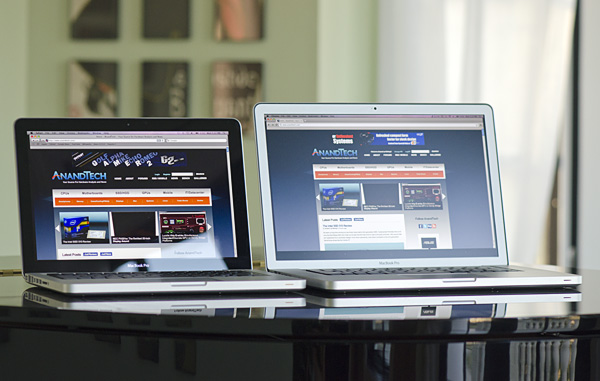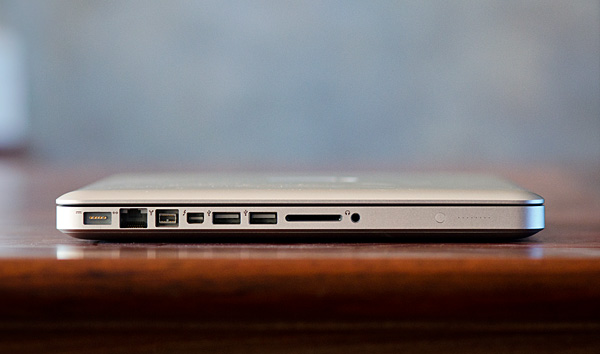The MacBook Pro Review (13 & 15-inch): 2011 Brings Sandy Bridge
by Anand Lal Shimpi, Brian Klug & Vivek Gowri on March 10, 2011 4:17 PM EST- Posted in
- Laptops
- Mac
- Apple
- Intel
- MacBook Pro
- Sandy Bridge
Final Words
For as little attention as the 2011 MacBook Pro launch was given by Apple, there sure is a lot to talk about.
The advantages are numerous. With the 13-inch MacBook Pro, under OS X at least, there simply aren't any downsides. You get much better CPU performance over the previous generation. In fact, the new 13 can outperform last year's 15 thanks to Sandy Bridge. The new 13 is quite possibly the best balance of portability and performance. It's the single largest upgrade you'll find in the lineup. If you own a previous generation 13-inch MBP, the upgrade is 100% worth it. Graphics performance is solid under OS X however questionable under Windows. For some reason we actually saw a step back in GPU performance vs. last year's 13-inch MBP when running games in Windows 7.
The 15-inch MacBook Pro is a beast. Although it comes in the same chassis as last year's model, it delivers much more performance. The move to quad-core Sandy Bridge makes the 15-inch MacBook Pro's performance formidable. Whereas I couldn't use the 2010 15 as my primary work machine, with an SSD the 2011 15-inch MBP does just fine.
Displays haven't really changed, which is both good and bad. On the one hand, Apple's MacBook Pros have always used good quality panels. On the other hand I'd like to see a higher res option for the 13-inch display—1280 x 800 is a big turnoff for me with the 13-inch model.
Thunderbolt is a nice addition however I expect that it'll be grossly underused for a while. We'll see some nice Thunderbolt enabled external storage solutions this Spring (helping perpetuate the mobile desktop usage model), but it'll be a while before we get the single-cable carrying USB, Ethernet, FireWire and DisplayPort to a display.
The WiFi improvements are welcome, although surprisingly absent from Apple's marketing collateral. The front facing 720p camera is also a nice touch.
It's not all rosy however. Apple fails to really take advantage of one of Sandy Bridge's biggest features: Quick Sync. The hardware encoder is used in FaceTime HD but you still get some very high CPU usage (at least of a single core). There's no support in QuickTime or iMovie 2011 for Quick Sync as of now, which is a major disappointment.
I mentioned that the 15-inch MacBook Pro is easily a desktop replacement, however you do have to deal with a loud fan under heavier CPU loads. Something a well designed desktop won't bother you with.
SSD support is still problematic. There are far too many reports of drives that don't work properly in the 2011 MacBook Pro, and Apple refuses to validate/ship anything but fairly mainstream SSD solutions. To make matters worse, although TRIM is finally enabled under OS X—it only works on Apple branded SSDs. I can understand Apple's desire to want to avoid dealing with the pitfalls of early SSDs with questionable firmware maturity, but I also believe it's Apple's duty to support as much hardware that's out there in the market today. If Apple offered something with SandForce SF-2200 class performance I'd have less of a bone to pick, but presently it doesn't.
Then there are the concerns about battery life. Under light usage there's a clear improvement over last year's models. The new 15-inch MacBook Pro is good for anywhere between 7—9 hours of light usage. That is assuming you don't have the dGPU running of course, at which point you should start talking about numbers below 5 hours. Even without the discrete GPU enabled, in the hands of a multitasker the new 15-inch MacBook Pro can easily burn through its 77Whr battery quicker than last year's model. While our worst case numbers don't look much lower than the 2010 model, the chances of you getting less than 2.5 hours out of the new 15 are much higher than they were last year.
The new 13-inch model is less of a concern when it comes to battery life. It's still got a 35W TDP dual-core CPU and no discrete GPU to sap power. It's the move to four cores and the additional GPU that really hurt the 15-inch MacBook Pro under heavy usage.
Overall the new lineup is a significant step forward. As I mentioned earlier, if you're in the market for a 13-inch system the 2011 Sandy Bridge MacBook Pro is likely the one to get. The 15 is just as easy to recommend, provided you're ok with the downsides (higher temperatures, louder fans, shorter battery life under load). If you aren't ok with the downsides, just wait another year and get the Ivy Bridge based successor.












198 Comments
View All Comments
robco - Thursday, March 10, 2011 - link
I made the mistake of buying a 15" MBP eighteen months ago and am stuck with a machine that has mediocre graphics and overheats constantly. Don't buy the MBP if you actually use it on your lap. That being said, the only reason I bought it over the MacBook was the dedicated graphics. With the awful performance of the Intel integrated chip, I hope Apple releases a 15" MacBook with the option of dedicated graphics for consumers. I'm not shelling out $2199 just to get something with a decent video card. I wouldn't recommend the 13" at all, as there are several alternatives in the 13-14" range that offer dedicated cards.I fell victim to the hype and now I have a fairly recent machine that can barely handle SC2 and an iPhone that can't make phone calls. Don't make the same mistake. Most of the tasks you can do on a Mac you can do on a Windows PC. Unless you are actually a pro and need a pro-grade machine, don't waste your money. For those who can justify the expense, they are nice machines, but if you actually put them to work, be ready to set them on a cool surface or get a cooling pad. They run awfully hot.
KoolAidMan1 - Thursday, March 10, 2011 - link
My MBP from last year plays SC2 perfectly, above 60fps most of the time which is great. Same with Source games. People on Youtube have already uploaded video playing the Crysis 2 demo on the new MBPs and it looks great.Your machine is almost two years old. Be logical when complaining about performance. Just because your machine is slow doesn't mean that the new ones aren't screaming fast: http://www.pcmag.com/image_popup/0,1740,iid=287468...
The 13" MBP is also decent with the SB IGP. I've seen clips on YT of people playing games even on the slower Macbook Air and it looks good. IGPs have come a long way from where they were in 2009.
robco - Thursday, March 10, 2011 - link
I'm a little miffed that a machine that was so expensive has become outdated rather quickly. I paid a lot just to get dedicated graphics. I could have and should have paid less to get a Windows notebook. I won't make the same mistake again. If you're a consumer and don't need a pro-grade machine but still want good graphics, the MBP is a poor value.The MBA actually handles games better than the new 13" MBP because it still uses the C2D and the NV integrated chipset. Once it switches to Sandy Bridge, performance will drop as it has with the MBP. The only area the MBA is slower than the MBP is raw processing power, graphics and disk access are much faster.
With Apple you can get a notebook that performs well, you just have to shell out $2199 to get it. I did that once, I won't do it again. it just isn't worth it unless you're a pro user who will recoup that cost in a short time. For consumers, it's a waste of money.
ImSpartacus - Thursday, March 10, 2011 - link
If you only needed the graphics muscle, you should've gotten a Windows laptop.Macbooks are for more mobile-minded users. They are thin, strong and have excellent battery life.
If you just need a solid mobile workstation that isn't going to be moved a lot, Windows laptops are a much better value.
SimKill - Friday, March 11, 2011 - link
ODM manufacturers like Clevo and Compal fit your bill perfectly. I got my system in 2009 August and even today I can play most of the games (ofcourse except godforsaken Crysis) at high settings at 1680x1050 (yep, 16:10) It cost me around $1400 but I'm very happy about it so far.SimKill - Friday, March 11, 2011 - link
Dam, they don't have an edit button. The hardware internals are pretty good with copper heatsinks and heatpipes and what not too...erple2 - Friday, March 11, 2011 - link
Hrm. Mac's are more of a semi-pro-grade machine. They still lack some of the important pro-grade features of an actual pro-grade machine. Like a Docking Station. Or a spill-resistant keyboard. Or a thumbprint reader. Or a smart card slot. Or a high-gamut monitor.While they are well constructed, they still don't have some of the critical features required for a good business laptop - they lack the all important OpenGL performance GPUs for wireframe models (among other things). See some of the high end Elitebooks or Thinkpads (which also cost a bit more than these MacBook Pros).
tipoo - Thursday, March 10, 2011 - link
Ah, I just had a dumb, nevermind me.IntelUser2000 - Thursday, March 10, 2011 - link
http://www.anandtech.com/show/4205/the-macbook-pro..."This is a weird one, since the same GPU gave us significantly better performance in the SNB test system."
Oh gee, I wonder why. The SNB test system used quad core and the Core i5 2410M is a dual core. Quad vs. Dual does have some impact.
Anand Lal Shimpi - Thursday, March 10, 2011 - link
It does have some impact, but not in this case. The HD 3000 is actually GPU bound in those tests - not to mention that most games aren't quite so well threaded that 2 v 4 cores should matter.Take care,
Anand